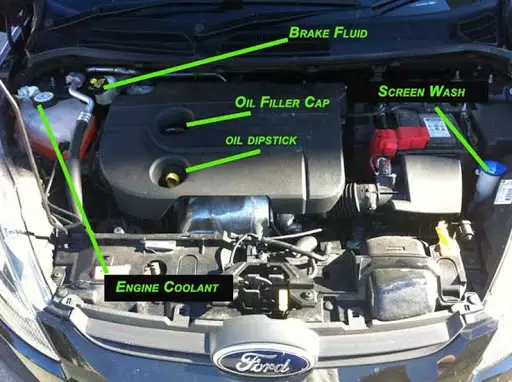How to check your car fluids - coolant, brake & windscreen
Topping up the engine coolant, brake fluid and windscreen washer fluid on your car
Checking your car fluids is easy and will save you unnecessary garage bills
All too often, new drivers don’t’ know how to do basic car maintenance tasks – like filling up the car fluids such as:
- Engine coolant (known as antifreeze).
- Brake fluid.
- Windscreen washer fluid.
Keeping your car fluids topped up is vital to making sure your vehicle stays safe to drive. If you don’t check these fluids regularly, you’ll notice small icons light up on your car’s dashboard.
Thankfully, topping up the car’s fluids it’s a straightforward task and here’s a quick guide on how to do it!

How do I top up my car’s coolant/antifreeze?
It’s shockingly easy to do so, and you don’t need to visit a mechanic!
First, you must use the right coolant for your engine! Check your manual and if any doubt, head to your local motoring stockist for advice.
Always double check if the antifreeze is premixed with water, otherwise, you’ll need to do that yourself.
To check if the level of your coolant is adequate:
- Look for the coolant reservoir usually a plastic container connected to the radiator. If you can’t find it, check your owners manual for the location.
- If the coolant does not come up to the “full” indicator or as indicated in your car manual then – you need to remove the reservoir cap and top up the coolant.
Beware: Opening the radiator cap when the engine is hot could lead to severe injury. It’s full of boiling water, and if you open the cap when it’s hot, this can surge out.
Newer cars have a radiator pressure cap that allows the cooling system to operate under pressure at higher temperatures for greater efficiency.
Older cars tend not to have a coolant reservoir – if this is the case, you will need to open the cap on the radiator instead.
Anything else I should check regarding the coolant system?
Funny, you should ask! Yes!
Take a glance at the radiator hoses they go into the top and the bottom of the radiator.
Check for cracks or leakage, and if necessary you’ll need to head to a garage for a replacement.
Warning!
Opening the radiator cap when the engine is hot could lead to severe injury. It’s full of boiling water, and if you open the cap when it’s hot, this can surge out.
You could end up with third-degree burns – so wait until it’s cooled down! Give the engine at least 30 minutes (after being turned off) to cool down.
How to check the brake fluid
The brake fluid reservoir is usually a plastic canister its location depends on the type of car you have.
Check your manual or local stockist to ensure you have the correct brake fluid.
Topping up the brake fluid:
Filling up your cars brake fluid is easy
- Find the reservoir: You might need to check your owners manual if you’re not sure what it is.
- Clean the top of the reservoir – any dirt or debris falling into fluid can affect the internal seals. Your brakes can lose effectiveness and even fail completely.
- Open the reservoir cap – only do this when you’re ready to fill up. Don’t leave it open for too long.
- Check the fluid level – if the brake fluid level is within half an inch or so of the cap, then it’s at a good level. If not, add brake fluid (the right one for your car!) until it reaches that point. Keep it between the high and low marks.
- Check the colour of your brake fluid – If your brake fluid is dark in colour, it’ll need replacing and should be done by a qualified mechanic.
Beware: If you notice a sudden drop in the fluid level, do not drive the car until a garage has fixed the problem.
Refilling the windscreen washer fluid
Replacing your windshield fluid is a breeze. It’s good practice to check it before a long drive – particularly in the winter.
- Buy some wiper fluid – you can find this at most supermarkets, as well as specialist motoring shops.
- Consult your owners manual – This can give you some specific suggestions in regards to refilling your fluid, and it’ll show you where the fluid container is.
- Find the container – Usually, there’s a large plastic cap with a windshield on it, so it’s easy to find!
- Fill it up – Using a filter, pour the liquid into the container until it reaches the fill line. If your fill line has deteriorated and you can’t see it, leave around a couple of inches of space at the top of the container.
